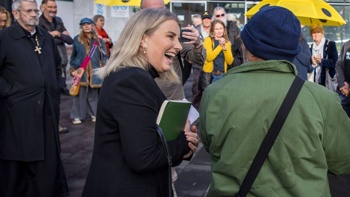
A Kiwi-born British rugby player accused of raping a woman in Rotorua 31 years ago was charged after advances in forensic science resulted in a DNA match, a Rotorua District Court jury has been told.
Chris Budgen, now aged 49, is on trial after pleading not guilty to a charge of sexual violation by rape of a woman in Rotorua in the early hours of September 15, 1991.
The Crown opened its case to the jury yesterday and said a then-18-year-old Budgen put his hand over the woman’s mouth, dragged her backwards down an alleyway off Amohau St and raped her against a wall.
Budgen had spent the night drinking at pubs after playing a game of rugby for an U19 representative side that was a curtain-raiser to an NPC match.
Budgen’s lawyer said it would be his client’s defence that he had consensual sex with a woman he had met that night - someone he did not have contact with again.
Crown prosecutor Anna McConachy took the jury through the circumstances of the case, saying the woman had gone to town on the night of September 14, 1991 with friends and had been drinking at a bar known as Wheelers, and then later at the Fenton Tavern - a bar where Valentines restaurant is now.
The woman could not find her friends and decided to leave the tavern at 2.20am.
McConachy said the woman had tried to call a taxi from the bar, but the phone had been busy.
She decided to instead walk down Amohau St towards a service station on the corner of Ranolf St where she planned to use a phone.
As she walked past late-night eating spot Joe’s Diner, she noticed a group of guys standing outside who were heckling her, McConachy said.
- Lawyer representing the parents who want unvaccinated blood for baby's surgery ahead of Tuesday's trial
- Brittany Higgins intends to file $3 million compensation claim after trial collapse
- National and Labour political donations trial: Chinese-NZ businessman avoids prison
She then walked past a rental car yard that had an alleyway that ran alongside it.
“She said she was walking past that alleyway, and out of nowhere she felt a hand across her mouth. That hand pulled her backwards, and her unknown attacker kept his hand across her mouth and pulled her backwards into a small alleyway off Amohau St.”
McConachy said the woman did not know what to do, and did not say or do anything out of fear. She did not know who the man was, but knew he was Pākehā and larger than her. He then raped her against a wall for what “felt like hours”. When he had finished, he left.
McConachy said the woman was later seen by Constable Eric Grace walking along Ranolf St, crying.
He offered her a ride home. Grace would give evidence that the woman was upset and he asked her if it was personal.
When he dropped her at her home, the woman said, “It depends what you mean by personal”. The woman then went inside her home, where she tried to call Rape Crisis and then called the police.
Police arrived at her home and took her to the police station to be interviewed and have a medical examination. On the way, she showed the police the alleyway where the rape happened.
She was examined by Dr Tricia Briscoe, who would give evidence she had a small bruise on her neck and blood on various parts of her body.
McConachy told the jury semen and blood stains were found on the crotch of a “black teddy” the woman had worn underneath a black dress. There was also semen found on the black dress. The articles of clothing were kept with the Crown’s research agency.
Police were unable to find any suspects for the woman’s attack and the case was closed.
It remained a cold case until 21 years later, when a forensic biologist contacted police and informed them a partial DNA sample had been obtained from the black teddy and it was possible a search of the DNA databank could find a lead.
McConachy said police agreed to open an inquiry. It resulted in 63 names being identified as a possible match from the DNA databank.
Ranked on that list was a relative of Budgen’s. This eventually lead police to the defendant, who had lived in New Zealand but had moved to the United Kingdom in 1997.
Police approached Chris Budgen, who said he had travelled to Rotorua on occasions for rugby but he “did not rape no chick”. He consented to giving a DNA sample.
Budgen’s DNA showed the likelihood was “4000 million times” more likely to be a match to the semen on the black teddy.
McConachy said that meant there was “extremely strong scientific support” that it was Chris Budgen’s DNA.
Police approached the Bay of Plenty Rugby Union and obtained a programme through a rugby historian for the game played at the stadium on September 14, 1991. It showed Budgen was the starting prop for the U19 North Zone team that played the U19 Central side.
Budgen told police he was with a woman on the night after the game, and went back to his travel lodge with her and had consensual sex.
Budgen’s lawyer, Sam Wimsett, gave a brief opening address to the jury saying there were obviously two sides to the story.
He said it would be a difficult job to assess what had happened 31 years ago involving young people when “booze” was a factor.
“He was in Rotorua that weekend playing representative rugby. During that weekend he had consensual sex with a woman in his room where he was staying.”
Wimsett said it was a consensual sexual encounter with a woman he did not know and whom he would never see again.
The defence case would look into whether the police’s investigation was fair to Budgen in how they collected evidence.
He asked the jury to remember they were a long way from knowing the full picture.
The trial, before Judge Eddie Paul, is expected to take four days.
Take your Radio, Podcasts and Music with you









